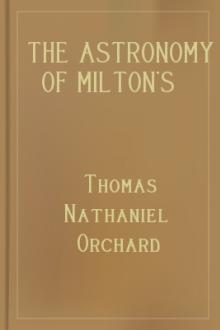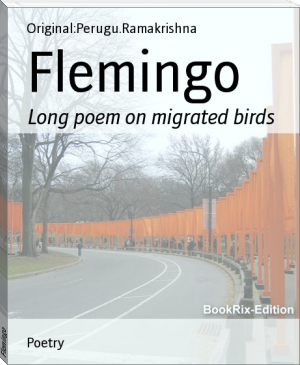The Astronomy of Milton's 'Paradise Lost' by Thomas Nathaniel Orchard (easy books to read in english TXT) 📕

- Author: Thomas Nathaniel Orchard
- Performer: -
Book online «The Astronomy of Milton's 'Paradise Lost' by Thomas Nathaniel Orchard (easy books to read in english TXT) 📕». Author Thomas Nathaniel Orchard
‘Although the corrected computation of Venus’ motions which I had before prepared, and on the accuracy of which I implicitly relied, forbade me to expect anything before three o’clock in the afternoon of the 24th, yet since, according to the calculations of most astronomers, the conjunction should take place sooner—by some even on the 23rd—I was unwilling to depend entirely on my own opinion, which was not sufficiently confirmed, lest by too much self-confidence I might endanger the observation. Anxiously intent, therefore, on the undertaking through the greater part of the 23rd, and on the whole of the 24th, I omitted no available opportunity of observing her ingress. I watched carefully on the 24th from sunrise to nine o’clock, and from a little before ten until noon, and at one in the afternoon, being called away in the intervals by business of the highest importance, which for these ornamental pursuits I could not with propriety neglect.[3] But during all this time I saw nothing in the Sun except a small and common spot, consisting as it were of three points at a distance from the centre towards the left, which I noticed on the preceding and following days. This evidently had nothing to do with Venus. About fifteen minutes past three in the afternoon, when I was again at liberty to continue my labours, the clouds, as if by divine interposition, were entirely dispersed, and I was once more invited to the grateful task of repeating my observations. I then beheld a most agreeable spectacle—the object of my sanguine wishes; a spot of unusual magnitude and of a perfectly circular shape, which had already fully entered upon the Sun’s disc on the left, so that the limbs of the Sun and Venus precisely coincided, forming an angle of contact. Not doubting that this was really the shadow of the planet, I immediately applied myself sedulously to observe it.
‘In the first place, with respect to the inclination, the line of the diameter of the circle being perpendicular to the horizon, although its plane was somewhat inclined on account of the Sun’s altitude, I found that the shadow of Venus at the aforesaid hour—namely, fifteen minutes past three—had entered the Sun’s disc about 62° 30', certainly between 60° and 65°, from the top towards the right. This was the appearance in the dark apartment; therefore, out of doors, beneath the open sky, according to the laws of optics, the contrary would be the case, and Venus would be below the centre of the Sun, distant 62° 30' from the lower limbs or the nadir, as the Arabians term it. The inclination remained to all appearances the same until sunset, when the observation was concluded.
‘In the second place, the distance between the centres of Venus and the Sun I found by three observations to be as follows:—
The Hour. Distance of the Centres. At 3·15 by the clock 14' 24'' At 3·35 by the clock 13' 30'' At 3·35 by the clock 13' 30'' At 3·45 by the clock 13' 0'' At 3·50 the apparent sunset.The true setting being 3·45, and the apparent about 5 minutes later, the difference being caused by refraction. The clock therefore was sufficiently correct.
‘In the third place I found after careful and repeated observation that the diameter of Venus, as her shadow was depicted on the paper, was larger indeed than the thirtieth part of the solar diameter, though not more so than the sixth, or at the utmost the fifth of such a part. Therefore let the diameter of the Sun be to the diameter of Venus as 30' to 1' 12''. Certainly her diameter never equalled 1' 30'', scarcely perhaps 1' 20'', and this was evident as well when the planet was near the Sun’s limb as when far distant from it.
‘This observation was made in an obscure village where I have long been in the habit of observing, about fifteen miles to the north of Liverpool, the latitude of which I believe to be 53° 20', although by common maps it is stated at 54° 12', therefore the latitude of the village will be 53° 35', and longitude of both 22° 30' from the Fortunate Islands, now called the Canaries. This is 14° 15' to the west of Uraniburg in Denmark, the longitude of which is stated by Brahé, a native of the place, to be 36° 45' from these islands.
‘This is all I could observe respecting this celebrated conjunction during the short time the Sun remained in the horizon: for although Venus continued on his disc for several hours, she was not visible to me longer than half an hour on account of his so quickly setting. Nevertheless, all the observations which could possibly be made in so short a time I was enabled by Divine Providence to complete so effectually that I could scarcely have wished for a more extended period. The inclination was the only point upon which I failed to attain the utmost precision; for, owing to the rapid motion of the Sun it was difficult to observe with certainty to a single degree, and I frankly confess that I neither did nor could ascertain it. But all the rest is sufficiently accurate, and as exact as I could desire.’
Besides having ascertained that the diameter of Venus subtends an angle not much greater than one minute of arc, Horrox reduced the horizontal solar parallax from fifty-seven seconds as stated by Kepler to fourteen seconds, a calculation within one and a half second of the value assigned to it by Halley sixty years after. He also reduced the Sun’s semi-diameter.
Crabtree, to whom Horrox refers as ‘his most esteemed friend and a person who has few superiors in mathematical learning,’ made preparations to observe the transit similar to those already described. But the day was unfavourable, dark clouds obscured the sky and rendered the Sun invisible. Crabtree was in despair, and relinquished all hope of being able to witness the conjunction. However, just before sunset there was a break in the clouds, and the Sun shone brilliantly for a short interval. Crabtree at once seized his opportunity, and to his intense delight observed the planet fully entered upon the Sun’s disc. Instead of proceeding to take observations, he was so overcome with emotion at the sight of the phenomenon, that he continued to gaze upon it with rapt attention, nor did he recover his self-possession until the clouds again hid from his view the setting Sun.[4]
Crabtree’s observation of the transit was, however, not a fruitless one. He drew from memory a diagram showing the exact position of Venus on the Sun’s disc, which corresponded in every respect with Horrox’s observation; he also estimated the diameter of the planet to be 7/200 that of the Sun, which when calculated gives one minute three seconds; Horrox having found it to be one minute twelve seconds. This transit of Venus is remarkable as having been the first ever observed of which there is any record, and for this we are indebted to the genius of Horrox, who by a series of calculations, displaying a wonderfully accurate knowledge of mathematics, was enabled to predict the occurrence of the phenomenon on the very day, and almost at the hour it appeared, and of which he and his friend Crabtree were the only observers.
Having thought it desirable to write an account of the transit, Horrox prepared an elegant Latin treatise, entitled ‘Venus in Sole Visa’—‘Venus seen in the Sun;’ but not knowing what steps to take with regard to its publication, he requested Crabtree to communicate with his bookseller and obtain his advice on the matter.
In the meantime Horrox returned to Toxteth, and arranged to fulfil a long-promised visit to Crabtree, which he looked forward to with much pleasure, as it would afford him an opportunity of discussing with his friend many matters of interest to both. This visit was frustrated in a manner altogether unexpected. For we read that Horrox was seized with a sudden and severe illness, the nature of which is not known, and that his death occurred on the day previous to that of his intended visit to his friend at Broughton. He expired on January 3, 1641, when in the 23rd year of his age.
His death was a great grief to Crabtree, who, in one of his letters, describes it as ‘an irreparable loss:’ and it is believed that he only survived him a few years.[5] Of the papers left by Horrox, only a few have been preserved, and these were discovered in Crabtree’s house after his death. Among them was his treatise on the transit of Venus which, with other papers, was purchased by Dr. Worthington, Fellow of Emmanuel College, Cambridge, a man of learning, who was capable of appreciating their value. Ultimately, the treatise fell into the possession of Hevelius, a celebrated German astronomer, who published it along with a dissertation of his own, describing a transit of Mercury.
Horrox did not live to see any of his writings published, nor was any monument erected to his memory until nearly two hundred years after his death. But his name, though long forgotten except by astronomers, is now engraved on marble in Westminster Abbey. Had his life been spared, it would have been difficult to foretell to what eminence and fame he might have risen, or what further discoveries his genius might have enabled him to make. Few among English astronomers will hesitate to rank him next with the illustrious Newton, and all will agree with Herschel, who called him ‘the pride and the boast of British Astronomy.’
William Gascoigne was born in 1612, in the parish of Rothwell, in the county of York, and afterwards resided at Middleton, near Leeds.
He was a man of an inventive turn of mind, and possessed good abilities, which he devoted to improving the methods of telescopic observation.
At an early age he was occupied in observing celestial objects, making researches in optics, and acquiring a proficient knowledge of astronomy.
Among his acquaintances were Crabtree and Horrox, with whom he carried on a correspondence on matters appertaining to their favourite study.
The measurement of small angles was found at all times to be one of the greatest difficulties which astronomers had to contend with. Tycho Brahé was so misled by his measurements of the apparent diameters of the Sun and Moon, that he concluded a total eclipse of the Sun was impossible.
Gascoigne overcame this difficulty by his invention of the micrometer. This instrument, when applied to a telescope, was found to be of great service in the correct measurement of minute angles and distances, and was the means of greatly advancing the progress of practical astronomy in the seventeenth century. A micrometer consists of a short tube, across the opening of which are stretched two parallel wires; these being intersected at right angles by a third. The wires are moved to or





Comments (0)